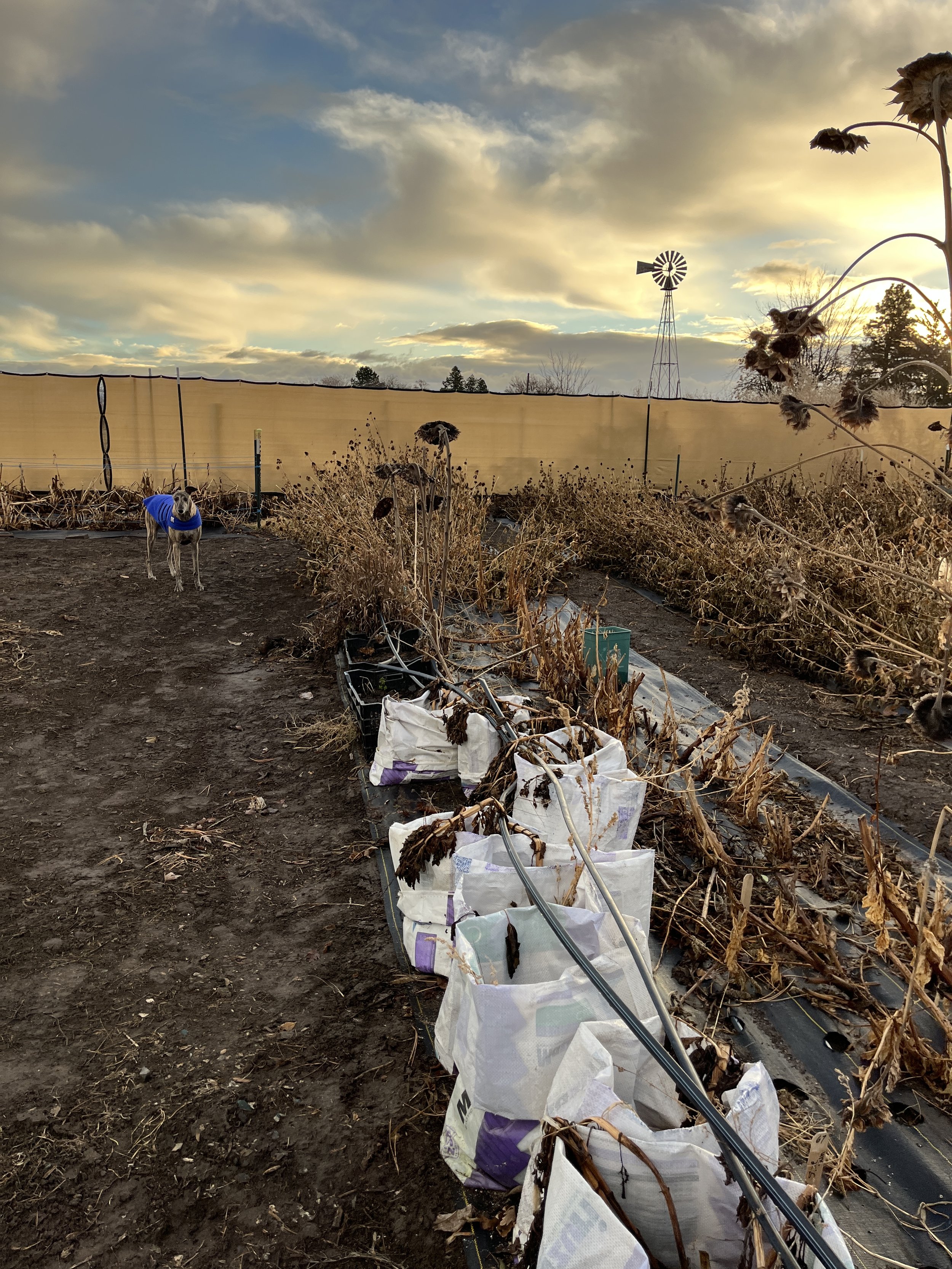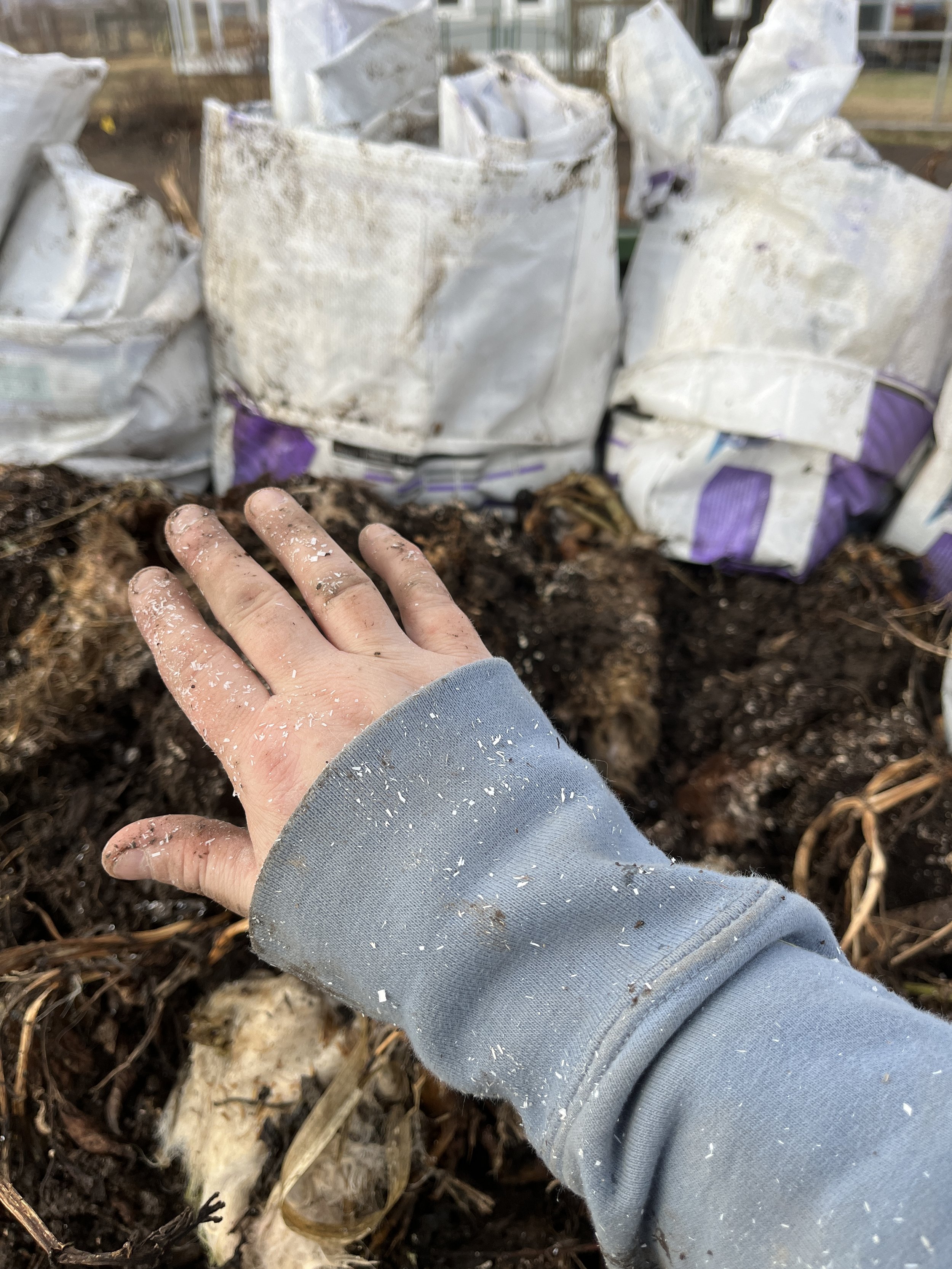alpacas & dahlias, part 3 final
Remember how I repurposed the alpacas feed sacks to be dahlia tuber grow sacks?
The goal of the project was twofold:
1) to see if it could be a viable option to grow some of the newer, more expensive varieties - but without the back breaking job of digging them, and
2) give a second life to these heavy duty plastic tarp like feed sacks that I have in abundance.
My hope was I could just dump the bag at the end of the season and collect the tubers.
So how did it go?
Well first off, without fail, I’m constantly re-learning that — if it ain’t on drip, it’s gonna die.
And in true form, I re-learned that again — after I got all of the sacks good & heavy and laid out — of course.
So you’ll see that I ran two lines of drip tape over the top. And let’s just say, that was a really ineffective bandaid in the long run. The wind took it every chance it got. And every time I turned the water on, one or both would pressurize and flop off. So I watered more of the ground than the actual plants!
In hindsight, it would’ve made more sense to dig a shallow trench, and roll down the sack sides more, to get them a bit more level with the ground.
That might’ve made the drip tape work better.
Then again, I think a small, automated overhead watering system would’ve been even better.
Here are a few other thoughts about the experiment:
PRO: Unintentionally planting decorative corn to act as a wind and shade block. Especially helpful in moisture retention when you consider my ineffective watering system.
PRO: Even with moderate neglect, this makeshift system worked - I had a few blooms even!
CON: The feed sacks began to deteriorate after a hot and dry Eastern Washington summer. I’m not sure why I didn’t consider this possibility at the inception since I know this to be true of any plastic-made thing around the farm.
CON: The plastic debris shards are everywhere, including in my soil.
CON: I thought placing them beside my final annual row would mean that I’d walk past ‘em enough to provide them sufficient oversight. It didn’t! Especially when that corn grew in. They just blended in with the scenery.
I took very few photos of the seasonal progress - but they made it into the majority of my selfies — not that I was trying!
PRO: They were easy to dump.
Since they were above ground, I knew I had to get to them quicker than the in-ground ones. But the reality of 2022 meant I had too much going on after the first light frost to actually dump and collect the tubers.
We had a kitchen renovation going on and a sick dog. Plus the holidays were looming. I just couldn’t bring myself to care.
I eventually got to them well after multiple sustained hard freezes, and to be expected, the were mushy and rotten.
Off to the compost it all went.
And the bags, sadly, into the trash.
Although I was initially resolved to consider this experiment a flop, after a few extra cups of coffee and time to really evaluate, I’d have to call it a win.
Why’s that?
Well because at the end of it all, I made a pretty substantial and worthwhile realization regarding dahlias.
Although I can easily grow them on the farm, and as I’ve proven I can even store them with the help of the alpacas, doing it on the scale I have been doing really isn’t something I’m going to continue.
Let me explain.
There’s a saying, Just because you can, doesn’t mean you should.
Do I want to grow dahlias? OH YOU BETCHA.
Do I need to grow any of those uber special, hard-to-find, super popular varieties? After all, that’s why I was doing this experiment in the first place, to make it easier for me to double-down on propagating those hard to get ones. The answer is DEFINITELY NOT.
Even with my very limited diversification — having fresh cut flowers as well as farm-grown fiber goods — trying to do everything all the other growers are doing just doesn’t work for me.
Yes, I can overwinter successfully in scrap fiber in my outbuildings — but do I have the energy to do that each and every year? No, no I don’t.
When fall hits, I’m working on selling my alpaca knitwear and yarns, and I’m already flat exhausted by all summer’s garden work.
Digging tubers is hard. Cleaning them so they’ll actually store is also hard. And then the worry of temperature fluctuations is just something I don’t want to be bothered with all winter.
And since I have wholesale accounts, I can buy whole clumps of tubers for literally a fraction of what I was paying via retail from other growers.
At first I thought — why would I want 25 clumps of one variety? And then I remembered how much like prefer to have more of a uniform offering for my subscribers.
Having a lot of one variety is actually a really good thing.
And you know what’s even gooder? I preorder my tubers, the wholesaler stores & worries about them all winter, then they get shipped to me right in time for planting.
BING. BANG. BATTABOOM!
Sure there could be a crop and storage loss, but you know what? I’ve never not been able to get wholesale clumps even without pre-ordering way ahead of time.
So I think going forward, I’m just going to order wholesale and let ‘em rot in the field at the end of the season like I did this year. And if I want to get a few fun ones here and there (cuz let’s be real other growers & dahlia breeders are pretty good marketers!), I can buy a couple. And I can store one box a year instead of 20!
Thanks for reading to the end. Here’s a cute alpaca picture for good measure.








